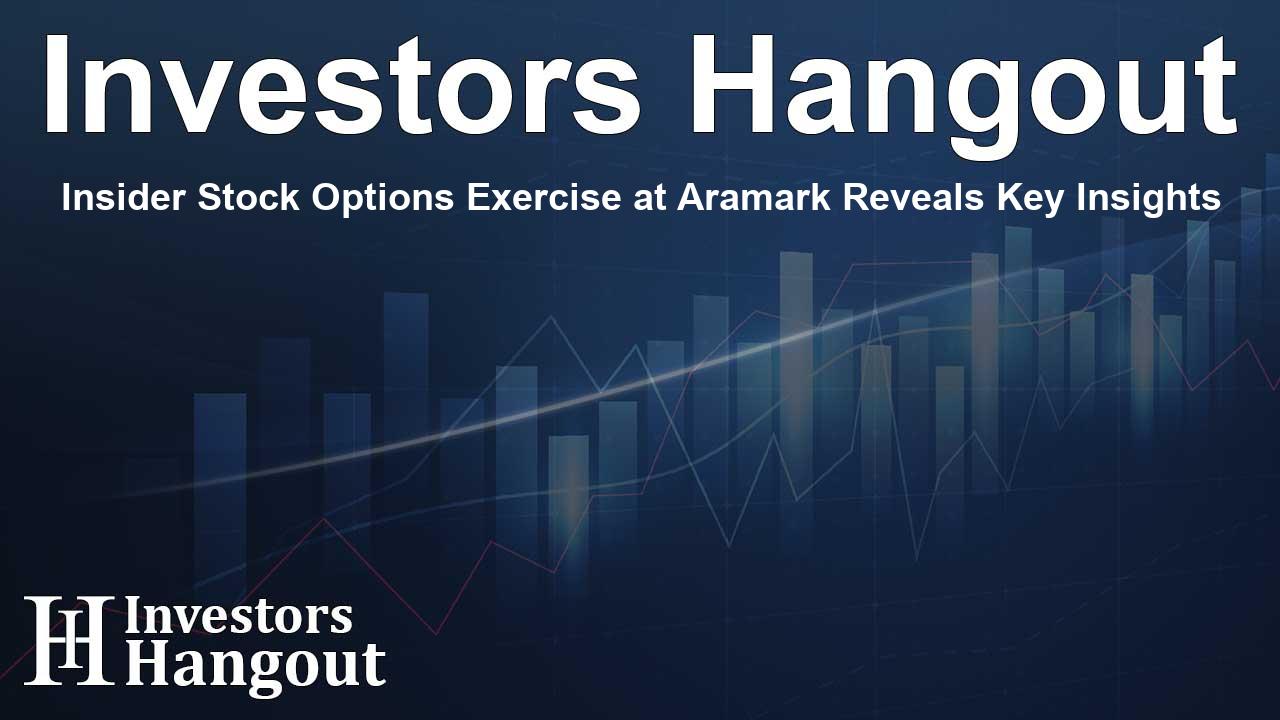Insider Stock Options Exercise at Aramark Reveals Key Insights

Insider Stock Options Exercise at Aramark Highlights Financial Trends
In a notable move within the corporate landscape, James Tarangelo, the Senior Vice President and Chief Financial Officer at Aramark, exercised a significant quantity of stock options. According to the recent filings with the SEC, this action was disclosed with an exercise amount totaling 8,365 shares of Aramark's stock.
The specific exercise price per share was recorded at $20.67, while the market saw a fluctuation, with shares currently trading around $38.46, representing a decline of approximately 4.85%. The total value of the shares exercised by Tarangelo amounts to about $148,813, a figure that further amplifies the significance of his actions within the market context.
A Comprehensive Examination of Aramark
Aramark stands as a multifaceted company that delivers vital services in food, facilities, and uniforms across various sectors. The core of Aramark's revenue generation stems from its North American food and support services, which serve a vast array of clients, ranging from educational institutions to healthcare facilities and entertainment venues. Additionally, the company’s uniform segment services customers in North America and Japan, reinforcing its expansive operational capabilities.
An Insight into Financial Performance
Recent financial analysis emphasizes a notable revenue growth trajectory for Aramark, as evidenced by a reported growth rate of 5.16% over recent months. This reflects an upward trend in revenue that enhances the company’s position, although it still trails behind some of its industry peers. Such growth, however, brings forth considerations regarding profitability.
Examining deeper into Aramark's financial ratios:
-
Gross Margin Analysis: One area of concern is the gross margin, which currently sits at 8.99%. This figure indicates potential operational challenges and issues with cost management when compared to peer companies.
-
Earnings Per Share (EPS): The company exhibits an earnings per share figure of 0.46, which is below industry standards, raising questions about its profit generation capabilities.
Debt Dynamics: Aramark’s debt-to-equity ratio reflects a more conservative approach to leveraging, with a ratio of 1.83. This lower reliance on debt financing may increase investor confidence, indicating prudent financial management.
Valuation Considerations:
-
Price to Earnings (P/E) Ratio: Aramark's P/E ratio currently stands at 40.83, suggesting potential undervaluation in comparison to the industry.
-
Price to Sales (P/S) Ratio: The P/S ratio at 0.62 invites attention, as it too suggests that the stock may be undervalued, offering a window for potential investors.
-
EV/EBITDA Ratio: The Enterprise Value to EBITDA ratio is 13.05, which could also indicate a disconnect in market valuation, presenting opportunities for investors seeking value.
Overall, Aramark’s market capitalization remains below industry benchmarks, which could stem from diverse factors including market expectations and operational efficiency.
The Significance of Insider Transactions
Understanding the context of insider transactions plays a crucial role in investment analysis. Stock transactions carried out by company insiders, including executives like Tarangelo, often reflect their perceptions regarding the company’s future prospects. In legal terms, an 'insider' may include corporate officers and major shareholders, all of whom must report their transactions promptly through regulatory filings.
Insider purchases can serve as strong signals of confidence in a company’s future performance. On the other hand, insider sells can occur for numerous reasons and should not always be interpreted as negative indicators.
Decoding Insider Transactions
Investors often scrutinize transactions based on the detailed disclosures found within regulatory filings. Each transaction is categorized by specific codes; for instance, a purchase is indicated by a 'P' while a sale is denoted by 'S.' Understanding these codes can provide greater context regarding insider sentiment and potential market movements.
Frequently Asked Questions
Who is James Tarangelo?
James Tarangelo is the Senior Vice President and Chief Financial Officer at Aramark, responsible for overseeing financial operations and corporate strategy.
What does Aramark do?
Aramark provides food, facilities, and uniforms services across various sectors, including education, healthcare, and entertainment, serving a diverse range of clients.
What is the significance of stock options exercises?
Stock options exercises by company insiders can indicate their confidence in the company’s future performance and can influence market perceptions.
How is Aramark performing financially?
Aramark has shown revenue growth, but challenges in gross margin and earnings per share raise questions about its overall profitability within the industry.
Why track insider transactions?
Tracking insider transactions can provide insights into company performance and management confidence, aiding investment decisions.
About Investors Hangout
Investors Hangout is a leading online stock forum for financial discussion and learning, offering a wide range of free tools and resources. It draws in traders of all levels, who exchange market knowledge, investigate trading tactics, and keep an eye on industry developments in real time. Featuring financial articles, stock message boards, quotes, charts, company profiles, and live news updates. Through cooperative learning and a wealth of informational resources, it helps users from novices creating their first portfolios to experts honing their techniques. Join Investors Hangout today: https://investorshangout.com/
Disclaimer: The content of this article is solely for general informational purposes only; it does not represent legal, financial, or investment advice. Investors Hangout does not offer financial advice; the author is not a licensed financial advisor. Consult a qualified advisor before making any financial or investment decisions based on this article. The author's interpretation of publicly available data shapes the opinions presented here; as a result, they should not be taken as advice to purchase, sell, or hold any securities mentioned or any other investments. The author does not guarantee the accuracy, completeness, or timeliness of any material, providing it "as is." Information and market conditions may change; past performance is not indicative of future outcomes. If any of the material offered here is inaccurate, please contact us for corrections.